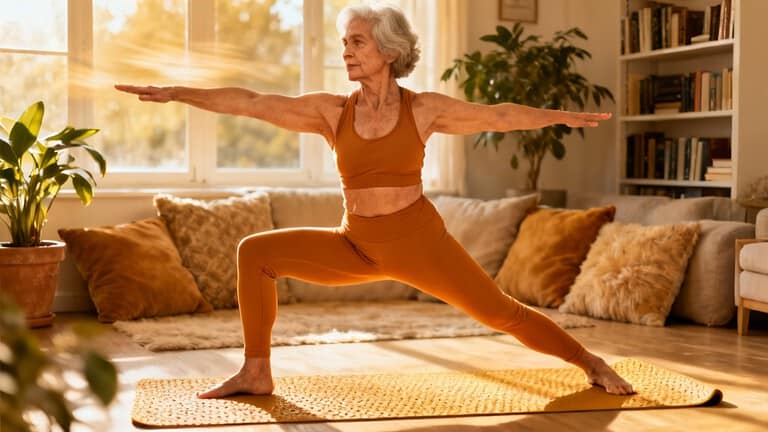What if you could build stronger muscles, improve your balance, and reduce pain without ever stepping into a gym or lifting a weight?
It might sound too good to be true, but it’s possible with isometric training. These powerful exercises work by holding still, activating deep stabilizer muscles that keep you upright, steady, and injury-free.
For adults over 50, isometrics are a game-changer. They’re low-impact, joint-friendly, and can be done anywhere.
In this article, we’ll explore five elite isometric exercises designed to preserve and elevate your strength. Let’s dive in and reclaim your confidence in movement.
1. Bird Dog Hold: Building Power from Stillness
The Bird Dog Hold may look simple, but it’s a powerhouse for activating deep stabilizer muscles. By reaching one arm forward and the opposite leg back while keeping your body stable, you train muscles that protect your spine, improve posture, and enhance balance.
How to Do the Bird Dog Hold
- Start on all fours with hands under shoulders and knees under hips.
- Engage your core by gently pulling your belly button toward your spine.
- Extend your right arm forward and left leg straight back.
- Hold for 10 to 20 seconds, keeping hips level and breathing steady.
- Switch sides and repeat 3 times per side.
Pro tip: Place a small book on your lower back. If it stays balanced, your form is solid.
Key Benefits
- Better posture and reduced slouching
- Stronger core and lower back
- Improved balance and spatial awareness
- Increased confidence in daily movements
2. Warrior Pose: Strength Meets Stillness
Warrior Pose isn’t just about flexibility—it’s a full-body isometric hold that builds stability, mobility, and mental resilience. This pose challenges your legs, hips, core, and focus, making it ideal for graceful aging.
How to Do The Warrior Pose
- Stand tall and step your right foot forward, left foot back 3–4 feet apart.
- Bend your front knee so it’s stacked above your ankle.
- Keep your back leg straight, foot angled slightly in.
- Raise both arms to shoulder height, palms down.
- Gaze over your front hand and hold for 20–30 seconds.
- Switch sides and repeat 2–3 rounds per side.
Form tip: Imagine pressing your front heel into the ground while pulling your back foot toward you to activate inner thighs and glutes.
Key Benefits
- Stronger legs for stairs and walking
- Improved hip flexibility and balance
- Enhanced focus and breath control
- Reduced chronic knee pain
3. Superman Hold: Activate the Back, Own Your Posture
The Superman Hold targets your posterior chain—the muscles along your back that keep you tall and pain-free. This simple move reverses imbalances caused by sitting and strengthens key postural muscles.
How to Do the Superman Hold
- Lie face down on a mat with arms extended forward.
- Lift your arms, chest, and legs slightly off the floor.
- Squeeze glutes and lower back, keeping neck neutral.
- Hold for 10–30 seconds, breathing steadily.
- Slowly lower and repeat for three sets.
Pro tip: If lifting both arms and legs is tough, start with just the upper body or alternate sides.
Key Benefits
- Improved posture and spinal alignment
- Reduced lower back stiffness
- Better core stability and balance
- Increased energy from upright movement
4. Wall Isometric Squat: Strength That Stands Its Ground
The Wall Isometric Squat is a safe, efficient way to build leg strength and core endurance. By leaning against a wall, you target quads, glutes, and hamstrings without stressing your knees or spine.
How to Do the Wall Squat
- Stand with your back flat against a wall, feet about 2 feet in front.
- Slide down until thighs are parallel to the floor or as low as comfortable.
- Keep knees above ankles, not past toes.
- Press lower back into the wall and hold for 20–40 seconds.
- Slide back up and repeat for 2–3 sets.
Tip: If parallel is too hard, start with a higher angle and work your way down.
Key Benefits
- Stronger legs and better knee control
- Increased endurance for standing and walking
- Improved joint alignment and balance
- Gentle calorie burn
5. Isometric Side Plank with Arm Raise: Core Stability at Its Finest
The Side Plank with Arm Raise is the crown jewel of core control. It masters balance, strength, and stability across your midsection, protecting your spine and preventing falls.
How to Do the Side Plank with Arm Raise
- Lie on your side, legs straight, elbow under your shoulder.
- Engage core and lift hips to form a straight line from feet to head.
- Raise top arm straight up, forming a T-shape.
- Keep hips lifted and body steady for 15–30 seconds.
- Switch sides and do 2–3 rounds per side.
Beginner tip: Keep your bottom knee on the ground for added support.
Key Benefits
- Enhanced side body strength and spinal stability
- Improved balance and fall prevention
- Better posture and alignment
- Reduced chronic low back pain
Conclusion: Embrace Strength at Any Age
These five isometric exercises—Bird Dog Hold, Warrior Pose, Superman Hold, Wall Squat, and Side Plank—offer a complete foundation for core control, postural strength, and joint stability.
They’re safe, effective, and sustainable, requiring no equipment and just minutes a day. Start small, stay consistent, and let your body reconnect with its innate strength.
Aging is inevitable, but how you move through life is a choice. Choose stability, confidence, and strength that grows with you.








